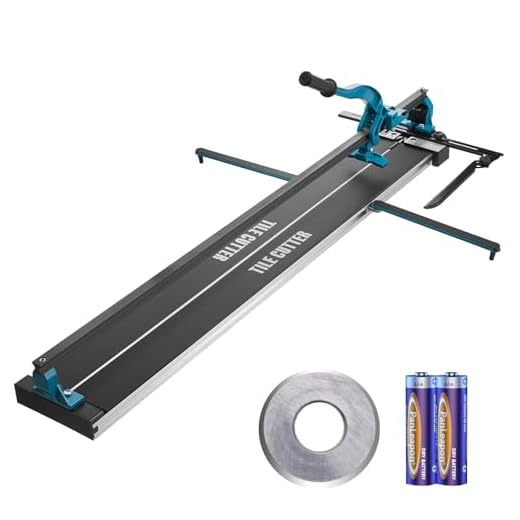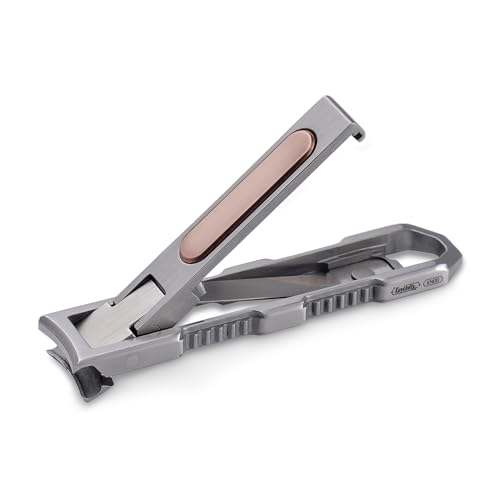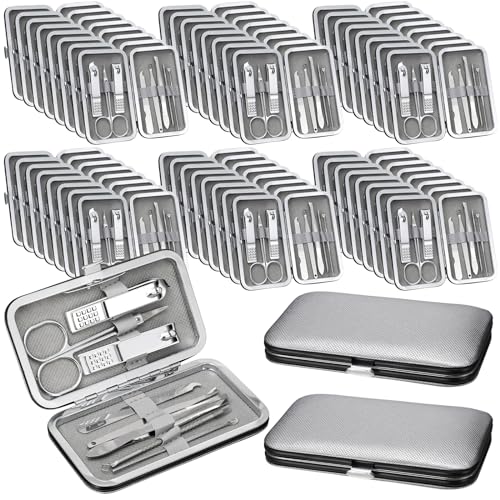
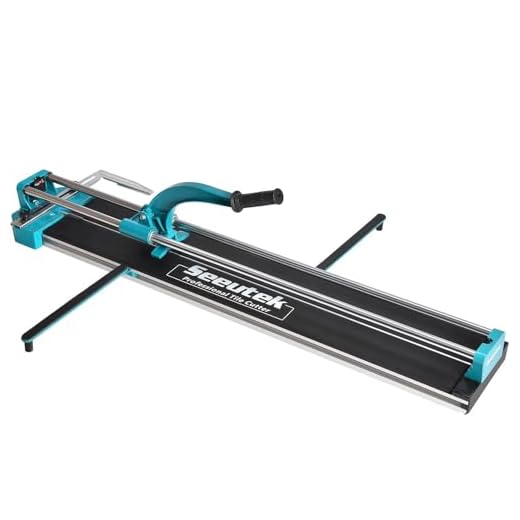
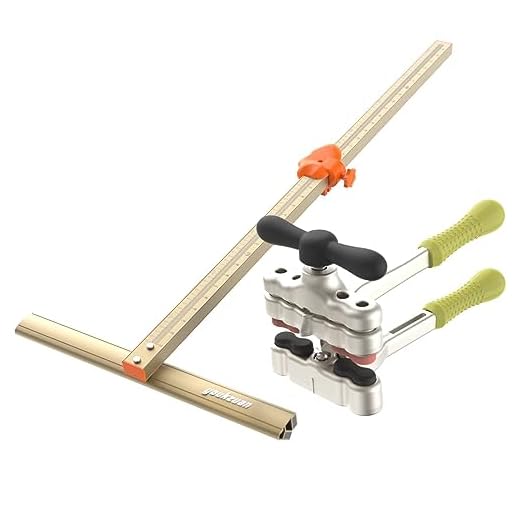
The process of cutting tiles can be a daunting task, especially if you don’t have access to expensive power tools. However, with a hand tile cutter and a few simple techniques, you can easily achieve clean and precise cuts for your tiling projects.
A hand tile cutter is a versatile tool that allows you to cut ceramic and porcelain tiles with ease. It consists of a scoring wheel, which creates a shallow scoreline on the surface of the tile, and a breaking mechanism, which helps you to snap the tile along the scored line.
Before starting to cut your tiles, it is important to measure and mark the desired cut lines accurately. Use a pencil or a marker to mark the cutting line on the surface of the tile. You can also use a straightedge or a square to ensure a straight and precise line.
Once you have marked the cutting line, position the tile in the hand tile cutter. Make sure that the line aligns with the scoring wheel. Apply gentle pressure and run the scoring wheel along the marked line, avoiding any unnecessary movements. It is important to score the tile only once, as multiple scores can weaken the tile and lead to uneven breaks.
After scoring the tile, place it on a flat surface, with the scored line facing up. Hold the tile firmly with one hand and use the breaking mechanism of the hand tile cutter to apply even pressure along the scored line. Slowly and steadily, exert pressure until the tile breaks along the scored line. If necessary, use a pair of tile nippers or a file to smooth the edges of the cut tile.
By following these simple steps, you can easily cut tiles with a hand tile cutter, making your tiling projects a breeze. Remember to work slowly and patiently, and always prioritize safety by wearing protective goggles and gloves. Happy tiling!
What Is A Hand Tile Cutter?
A hand tile cutter is a tool used for cutting tiles of various materials, such as ceramic, porcelain, or glass. It is a manual cutting device that allows precise and accurate cutting of tiles to fit specific dimensions or shapes. Hand tile cutters are commonly used in DIY projects or smaller tile installations where professional-grade equipment is not required.
These tools typically consist of a durable base with a cutting guide and a scoring wheel. The base provides stability and support for the tile being cut, while the cutting guide helps to ensure straight and consistent cuts. The scoring wheel, usually made of tungsten carbide, is used to create a score or groove along the surface of the tile. This score weakens the tile and allows it to be easily broken along the desired cut line.
Using a hand tile cutter requires some skill and practice to achieve clean and accurate cuts. The operator needs to align the tile correctly, apply pressure and score the tile with a steady hand. Once the tile is scored, it can be snapped or broken along the scored line using the breaking mechanism of the tile cutter. For more intricate cuts or shapes, additional tools like nippers or a wet saw may be necessary.
Hand tile cutters are a versatile and cost-effective option for cutting tiles. They are compact, portable, and do not require a power source, making them ideal for trimming or cutting tiles on site. Whether you’re a DIY enthusiast tackling a home improvement project or a professional tile installer working on smaller jobs, a hand tile cutter is a useful tool to have in your arsenal.
Understanding The Basics
Before you start cutting tiles with a hand tile cutter, it’s important to understand the basics of how the tool works and how to use it safely and effectively.
A hand tile cutter, also known as a score and snap cutter, is a manual tool used to cut ceramic and porcelain tiles. It consists of a sharp cutting wheel and a base with measurements for accurate cuts.
To use a hand tile cutter, you’ll need to score or scratch the surface of the tile along the desired cutting line. This creates a weak point in the tile, making it easier to break. You can then use the built-in snapping mechanism on the cutter to break the tile along the scored line.
It’s important to note that a hand tile cutter is best suited for straight cuts and is not ideal for cutting curves or complex shapes. For these types of cuts, you’ll need to use a different tool like a wet saw or tile nipper.
When using a hand tile cutter, be sure to wear safety goggles to protect your eyes from tile shards and debris. Additionally, take your time and apply consistent pressure when scoring the tile to ensure a clean and precise cut.
By understanding these basics and following best practices, you’ll be well-equipped to use a hand tile cutter effectively and achieve professional-looking results in your tile-cutting projects.
Types Of Hand Tile Cutters
Hand tile cutters come in different types, each suited for specific tile cutting needs. Whether you are a professional or a DIY enthusiast, knowing the different types of hand tile cutters available can help you choose the right tool for the job.
1. Snap Tile Cutters
Also known as a manual tile cutter, a snap tile cutter is one of the most popular types of hand tile cutters. It features a scoring wheel and a breaking bar that allows you to score the tile’s surface and then snap it along the scored line. Snap tile cutters are ideal for straight cuts and are commonly used for ceramic and porcelain tiles.
2. Compound Tile Nippers
Compound tile nippers consist of two blades that are squeezed together to cut tiles. They are versatile tools that can be used to make curved or irregular cuts. Compound tile nippers are commonly used for cutting small sections of ceramic, glass, or stone tiles.
3. Tile Scorer
A tile scorer, also known as a tile scriber, is a simple hand tool that is used to score tiles before breaking them. It features a hardened steel point that is used to create a scoring line on the tile’s surface. Once scored, the tile can be broken along the line using hand pressure or a breaking bar.
When using a tile scorer, it is important to keep the tool at a slight angle to create a clean and precise score line.
4. Tile Hole Cutter
A tile hole cutter is a specialized hand tool used to create holes in tiles for pipes or other fixtures. It features a carbide-tipped drill bit that is mounted on a rotating guide. By slowly rotating the cutter and applying light pressure, you can slowly bore a hole into the tile. Tile hole cutters are commonly used for ceramic and porcelain tiles.
| Tool | Features | Common Uses |
|---|---|---|
| Snap Tile Cutter | Scoring wheel and breaking bar | Straight cuts on ceramic and porcelain tiles |
| Compound Tile Nippers | Two squeezing blades | Curved or irregular cuts on ceramic, glass, or stone tiles |
| Tile Scorer | Hardened steel point | Scoring tiles before breaking |
| Tile Hole Cutter | Carbide-tipped drill bit | Creating holes in tiles for pipes or fixtures |
How To Choose The Right Hand Tile Cutter
When it comes to cutting tiles, having the right hand tile cutter is essential. With so many options available, it can be challenging to choose the right one for your needs. Here are some key factors to consider when selecting a hand tile cutter:
1. Type of cutter
There are different types of hand tile cutters available, each designed for specific tile materials and sizes. The most common types include snap cutters, score and snap cutters, and wheel cutters. Snap cutters are ideal for ceramic and porcelain tiles, while score and snap cutters are perfect for vinyl and thin tiles. Wheel cutters are suitable for thicker materials like glass and stone.
2. Cutting capacity
Consider the size and thickness of the tiles you usually work with. Ensure that the hand tile cutter you choose can accommodate the maximum size and thickness of tiles you will be cutting. It’s better to opt for a larger cutting capacity to give yourself more flexibility for future projects.
3. Blade quality
The quality of the blade on a hand tile cutter is crucial for clean and precise cuts. Look for a cutter with a sharp, durable blade that can easily glide through the tile material without chipping or cracking. Also, check if the blade is replaceable so you can maintain its performance over time.
4. Ease of use
Using a hand tile cutter should be a straightforward process. Look for a cutter that is easy to grip and maneuver, with a comfortable handle. It should also have adjustable features for accurate cutting and a clear cutting guide to help you align the tiles correctly.
5. Portability
If you often work on different job sites or need to move around while cutting tiles, consider the portability of the hand tile cutter. Look for a lightweight and compact option that is easy to transport, yet still sturdy enough to handle your cutting needs.
By considering these factors, you can choose the right hand tile cutter that will make your tile cutting projects more efficient and accurate.
Step-By-Step Guide To Cutting Tiles
If you are planning to cut tiles for a DIY project, a hand tile cutter can be an excellent tool to use. Here is a step-by-step guide to help you achieve accurate and clean cuts.
- Start by measuring and marking the tile where you want to make the cut. Use a straightedge or a square to ensure that your lines are straight and precise.
- Next, set up your hand tile cutter according to the manufacturer’s instructions. This usually involves securing the tile in place and adjusting the cutting wheel.
- Once your tile is secured, align the cutting wheel with the marked line on the tile. Apply gentle pressure and score the tile along the line. Always score the glaze side of the tile to ensure a clean break.
- After scoring the tile, gently apply pressure to both sides of the scored line. This will help break the tile along the scored line. If necessary, use a pair of tile nippers to remove any remaining pieces.
- Continue this process for each tile that needs to be cut. Take your time and ensure that each cut is accurate and clean.
- If you need to make curved cuts or odd-shaped cuts, use a tile scribe or a tile saw instead of a hand tile cutter. These tools offer more flexibility and precision for complex cuts.
- Remember to wear safety goggles and gloves while cutting tiles to protect yourself from flying debris and sharp edges.
- Once you have finished cutting all the tiles, clean up any debris and wipe down the tiles to remove any dust or residue.
- Finally, install the cut tiles according to your project’s requirements, using the appropriate adhesive and grout.
Following these steps will help you cut tiles like a pro using a hand tile cutter. Remember to practice on scrap tiles before cutting the ones for your project to gain confidence and accuracy.
Tips and Tricks For Using A Hand Tile Cutter
Using a hand tile cutter can be intimidating, but with the right techniques and knowledge, you can achieve professional-looking results. Here are some tips and tricks to help you get the most out of your hand tile cutter:
1. Choose the right blade: Different tile materials require different blades. Make sure you select a blade that is suitable for the type of tile you are cutting.
2. Mark your tiles: Before cutting, carefully measure and mark the tiles where you want to make the cuts. This will help ensure accuracy and prevent mistakes.
3. Practice before cutting: If you are new to using a hand tile cutter, it’s a good idea to practice on some scrap tiles first. This will give you the opportunity to familiarize yourself with the tool and perfect your technique.
4. Use even pressure: When cutting the tile, apply even pressure to achieve clean and precise cuts. Avoid exerting too much force, as this can cause the tile to crack or break.
5. Score the tile: Start by scoring the tile with the cutter wheel. Apply firm pressure to create a visible groove on the surface of the tile.
6. Snap the tile: Once the tile is scored, use the snapping mechanism of the hand tile cutter to break it along the scored line. This requires applying pressure evenly on either side of the score line.
7. Keep your hands safe: To avoid injuries, always wear gloves when handling the tile cutter. Additionally, make sure to keep your hands clear of the cutting area.
8. Clean the blade: After each use, clean the blade of the tile cutter to prevent any residue from affecting future cuts. A clean blade will ensure smoother and more precise cuts.
By following these tips and tricks, you will be able to effectively use a hand tile cutter to cut tiles with accuracy and ease.

